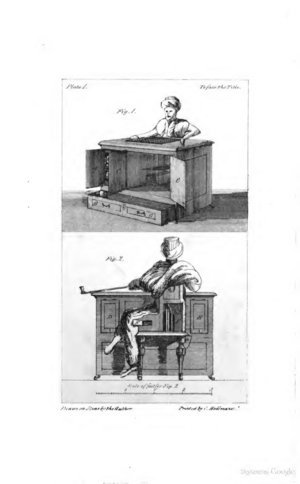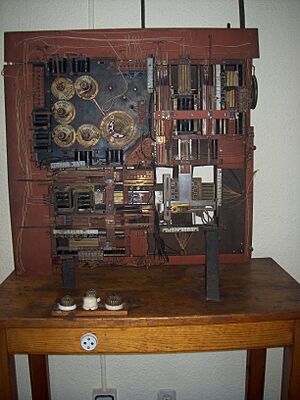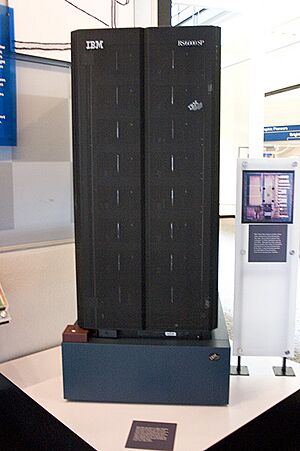History of chess engines facts for kids
Chess has a long and exciting history, going back almost 1500 years! But in the last 70 years, something really big changed the game: chess engines. These are computer programs designed to play chess. They have completely changed how top-level chess is played today.
Contents
Early Chess Machines (Before 1940s)
Even before modern computers, people dreamed of machines that could play chess.
The Mechanical Turk
One of the first famous chess machines was called the Mechanical Turk. It appeared in the 1700s. A Hungarian inventor named Wolfgang von Kempelen built it. The Mechanical Turk looked like a life-sized human model. It was shown off in 1770 as the world's first chess-playing robot.
The Turk could play chess and even beat strong players. It could also solve a famous chess puzzle called the knight's tour. The Mechanical Turk worked from 1770 until 1854. It was later destroyed in a fire. Years after it stopped working, people found out the truth. A human chess player was actually hidden inside the machine, controlling its moves! It was a clever trick.
El Ajedrecista
In 1912, a real chess computer was built by Leonardo Torres Quevedo. He named his machine El Ajedrecista. Unlike the Mechanical Turk, El Ajedrecista was truly an automatic machine. It could play chess all by itself.
El Ajedrecista could play a specific part of a chess game called an endgame. In this game, White had a king and a rook, and Black only had a king. The machine could always checkmate the Black king. It could also tell if a human player made an illegal move. El Ajedrecista was the first true chess engine. It made many people excited about the future of chess and computers.
Computers Learn Chess (1940s–1950s)
World War II brought amazing new technologies, especially the computer. Two important thinkers, Alan Turing and Claude Shannon, led these changes. After the war, both became interested in computer chess.
In 1950, Claude Shannon wrote about a program that could play chess against a human. A year later, Alan Turing created the first computer chess program. But the computers back then were not powerful enough. Turing had to test his program by playing the moves himself. Even though his program was simple, Turing and Shannon had started something big.
In 1951, Dietrich Prinz, a friend of Turing, made a basic chess program. It could solve a "mate in two" puzzle. This program ran on the Ferranti Mark 1, one of the first computers sold to businesses. It wasn't strong enough to play a full game. But it proved that chess computing was possible.
Finally, in 1957, an engineer named Alex Bernstein created the world's first fully automatic chess engine. It was built for a large computer called the IBM 704. This engine took about eight minutes to make each move. But it could play an entire game! This was the real start of chess computing.
Chess Engines Grow Stronger (1960s–1970s)
Computers got much better in the 1960s and 1970s. This helped chess engines become much stronger. Both software (the programs) and hardware (the computer parts) improved a lot.
Software Improvements
A very important computer idea is the Minimax algorithm. It helps computers make the best choices in games. It tries to get the highest score for one player while making the other player's score as low as possible. This idea was first shown in 1928 by John von Neumann.
For chess, a special trick called alpha-beta pruning was added to Minimax. This helped chess programs look deeper into possible moves. Other improvements included better ways to pick moves, using smart guesses (heuristics), and looking deeper into moves step by step. Programs also started using databases of opening moves and endgames.
Some chess grandmasters, like former World Champion Mikhail Botvinnik, even helped improve chess programming. They used their deep knowledge of the game to make engines better.
Hardware Improvements
In the early days, slow computers were the biggest problem for chess engines. But computer hardware got much faster. In 1965, Gordon Moore noticed something amazing. The number of tiny switches (transistors) on computer chips was doubling every two years. This made computers much faster, very quickly! This idea is now called Moore's law.
Special computer parts for chess engines also became popular. In 1978, a chess engine named Belle won a big competition. It was called the North American Computer Chess Championship. Belle had special hardware that let it look at about thirty million chess positions in just three minutes! Belle also had databases of opening and ending moves. Two years later, Belle became the first chess engine to earn a Master rating.
Humans vs. Machines (1960s–2000s)
In the 1960s and 1970s, even the best chess engines couldn't beat top human players. In 1968, a chess master named David Levy bet $3000. He said no chess engine could beat him in the next ten years. In 1977, Levy played against an engine called Kaissa. He won the match without losing a single game.
In 1980, a computer science professor named Edward Fredkin offered prizes. He wanted chess engines to reach new levels. He offered $10,000 for the first engine to become a Grandmaster. He also offered $100,000 for the first engine to beat a world chess champion. This made the competition in computer chess very serious.
Deep Blue
The famous chess computer Deep Blue started as a project called ChipTest. It was built by Feng-hsiung Hsu, Thomas Anantharaman, and Murray Campbell. They entered ChipTest in a championship in 1986. It didn't win, but they came back the next year with a better version and won every game.
In 1988, the team built a new machine called Deep Thought. Deep Thought was much better than earlier engines. It became the first engine to beat a grandmaster. This happened when it played against Bent Larsen in a regular tournament game. The next year, Deep Thought won the World Computer Chess Championship. It won all five of its games.
Chess engines still hadn't beaten humans completely. Deep Thought lost two matches to the world champion, Garry Kasparov, that same year. For several years, Deep Thought remained the top chess engine. It was later improved and called Deep Thought 2. It won the North American Computer Chess Championship five times. In 1994, IBM started supporting the team.
Finally, in 1995, a new chess engine was released by the IBM team. It was called Deep Blue. The engine was finished in 1996. That same year, it played against chess champion Garry Kasparov for the first time. Kasparov won the six-game match by a score of 4–2. But this was the first time a chess engine had won a game against the current world champion in a regular match!
Deep Blue was upgraded by engineers and top chess grandmasters. A year later, the IBM team had another chance. In a very famous match, Deep Blue became the first chess engine to beat the current world chess champion in a full match. Kasparov made some claims that IBM had cheated. But the result was a huge step forward for chess computing.
Super-Human Engines (2000s–Today)
Kasparov's loss showed that the best humans could no longer beat the best engines. More money went into chess computing, and the field grew quickly. But there were some problems. In 2011, the engine Rybka, which had won four championships, was disqualified. This was because it had copied parts of its code from other engines.
New competitions started, like the Top Chess Engine Championship in 2010. These competitions focused on automated play and longer games. They also allowed stronger computer hardware.
Until the late 2010s, chess computing kept getting better slowly. Engines became stronger than ever. Then, in 2017, something big happened. A team at Google's company DeepMind released a brand new engine called AlphaZero.
Neural Network Revolution
In late 2017, engineers at DeepMind released an engine that surprised everyone in the chess world. AlphaZero used a completely new way to play chess. Older engines looked through many possible moves and rated each position. But AlphaZero used something called a deep neural network for its analysis. This meant AlphaZero could learn chess all by itself, without being told specific rules.
The first tests with AlphaZero were amazing. It played 100 games against Stockfish, which was the strongest engine at the time. AlphaZero won 28 games and tied the other 72. AlphaZero was a huge breakthrough not just for chess, but for the world of Artificial Intelligence (AI) in general.
Since 2017, neural networks have become very important in top chess engines. Today, engines like Leela Chess Zero, Stockfish, and Komodo all use neural networks.
See also
- Computer chess




